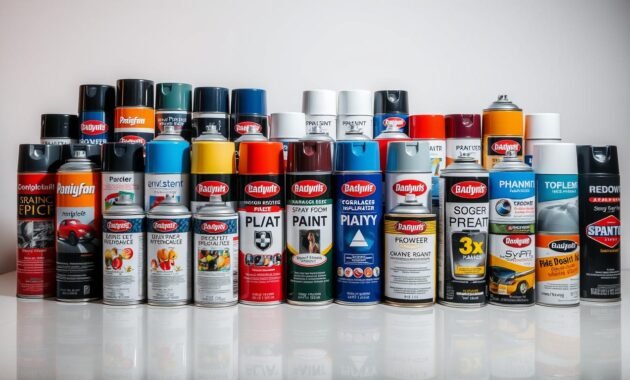Many homeowners face the challenge of spray foam insulation’s dull look. They wonder if they can improve its appearance without losing its effectiveness. The gray or yellow color can make your walls look unfinished, causing frustration.
Painting spray foam insulation is doable, but it needs the right approach. I’ll show you how to give your insulation a new look with paint. This way, you can keep its insulating qualities while making it look better.
This guide will teach you how to paint spray foam insulation well. You’ll learn about the best paints to use and how to get a professional finish. This will enhance your home’s look inside and out.

Understanding Spray Foam Insulation Basics
Spray foam insulation is a top choice for making homes more energy efficient. As a construction expert, I’ve seen how it changes how buildings work. It blocks heat and keeps air out very well.
Read also: Spray Foam Insulation Mold Problems
There are two main types of spray foam: open cell and closed cell. Each has its own strengths for different uses.
Types of Spray Foam Insulation
- Open cell spray foam:
- Softer and more flexible
- Allows moisture vapor transmission
- Typically less expensive
- Ideal for interior walls and sound dampening
- Closed cell spray foam:
- Denser and more rigid
- Provides superior moisture barrier
- Higher R-value per inch
- Excellent for exterior and below-grade applications
Common Applications in Buildings
Experts use foam insulation in many parts of buildings. It’s great for attics, walls, crawl spaces, and roofs. Its ability to fill gaps is better than old insulation methods.
Natural Colors and Appearance
When first applied, spray foam is light yellow, off-white, or pale green. Many homeowners want to paint or cover it for looks.
| Insulation Type | R-Value per Inch | Moisture Resistance | Best Used In |
|---|---|---|---|
| Open Cell Spray Foam | 3.5 – 4.0 | Low | Interior Walls |
| Closed Cell Spray Foam | 6.0 – 7.0 | High | Exterior/Moisture-Prone Areas |
Why Consider Painting Spray Foam Insulation
Painting spray foam insulation is more than just making it look good. It’s a smart choice that boosts your home’s performance and safety. By adding insulation paint, you get benefits that go beyond just looks.
- Enhanced UV Protection: Spray foam insulation colors can shield the material from sun damage
- Improved Durability: Insulation paint adds an extra protective layer against environmental wear
- Aesthetic Customization: Match your insulation to your interior or exterior design preferences
- Increased Fire Resistance: Some specialized paints provide additional fire-retardant properties
Experts say painting spray foam insulation is a good idea. The right paint can protect it from sunlight, moisture, and temperature changes. It’s like adding a shield to keep your insulation working well.
| Benefit | Impact |
|---|---|
| UV Protection | Prevents material breakdown |
| Aesthetic Appeal | Seamless integration with design |
| Surface Protection | Reduces possible damage |
Knowing these benefits helps you decide to paint your spray foam insulation. It’s a smart move for your home’s future.
Can You Paint Spray Foam Insulation: A Complete Guide
Painting spray foam insulation needs careful thought and special techniques. I’ll guide you through the key steps to paint your spray foam right. This way, it keeps its protective qualities.
For painting spray foam, acrylic latex paint is the best choice for most jobs. Not all paints are good for spray foam insulation. So, knowing which ones work is key.
Read also: How to Smooth out Expanding Foam
Paint Compatibility Factors
- Acrylic latex paint offers great coverage and flexibility
- Water-based paints usually work best on spray foam
- Stay away from oil-based paints that can harm the foam
Timing After Installation
Timing is everything when painting spray foam insulation. I suggest waiting 24-48 hours after it’s installed. This lets the foam cure fully, making it ready for paint.
Surface Preparation Requirements
- Clean the spray foam surface well
- Look for any surface blemishes
- Apply a primer made for spray foam insulation
- Make sure the surface is dry before painting
Choosing the right way to paint spray foam is important. It affects both how it looks and how well it works. By following these tips, you’ll get a professional look that also protects your spray foam insulation.
Selecting the Right Paint for Spray Foam
Finding the right paint for spray foam insulation can be challenging. Not every paint is suitable for this material. I’ll guide you through the selection process to get the best results for your project.

Acrylic latex paint is the best choice for spray foam insulation. These paints are water-based and perform exceptionally well. When picking a paint for your insulation, remember these important points:
- Flexibility to move with the spray foam’s surface
- Superior adhesion capabilities
- Resistance to cracking and peeling
- Breathability to prevent moisture buildup
Look for specific traits in your acrylic latex paint. The best paint should:
- Be made for foam surfaces
- Provide excellent coverage
- Offer UV protection
- Resist temperature changes
Stay away from oil-based paints or those with harsh chemicals. They can harm the foam’s surface and reduce its insulation. Experts often recommend using paint sprays made for spray foam for the best outcome.
When you’re shopping for paint, find products marked as foam insulation compatible. Brands like Sherwin-Williams and Benjamin Moore have great options that fit these needs.
Essential Surface Preparation Steps
Preparing spray foam insulation for painting needs careful steps. I’ll show you how to get a smooth, lasting paint finish. This protects your foam and makes it look better.
Preparing foam insulation for painting involves several key steps. The right preparation prevents issues like poor adhesion or uneven coverage.
Cleaning and Degreasing Methods
Proper cleaning is key for spray foam insulation. Here’s what I recommend:
- Start with a mild detergent and water for cleaning
- Use isopropyl alcohol for deep degreasing
- Make sure to remove all dust, dirt, or contaminants
- Let the surface dry completely before moving on
Sanding Techniques
Sanding makes the surface smooth for painting. Here’s how to do it:
| Sanding Tool | Grit Level | Purpose |
|---|---|---|
| Fine-grit sandpaper | 120-180 grit | Smooth out rough surfaces |
| Sanding block | Medium pressure | Ensure even surface |
| Dust removal brush | N/A | Clean surface after sanding |
Priming Requirements
Choosing the right primer is vital for foam insulation. Use a primer made for foam surfaces for best adhesion and protection.
- Choose a primer that works with spray foam
- Apply thin, even coats
- Let it dry fully between coats
- Follow the manufacturer’s advice for your foam type
By following these steps, you’ll get your spray foam insulation ready for painting. This ensures a professional and lasting finish.
Benefits of Painting Spray Foam Insulation
Painting your spray foam insulation does more than just make your home look better. It’s a smart move to boost your home’s insulation system. Let’s explore the main benefits of using insulation paint.
Enhanced Durability
Painting your spray foam insulation adds a protective layer. This layer helps it last longer. The right paint shields it from moisture, UV rays, and extreme temperatures.
Improved Aesthetics
Spray foam insulation isn’t always easy on the eyes. Painting it lets you match it with your home’s look. This makes it look finished and polished.
Additional Protection Features
- Increased fire resistance
- UV damage prevention
- Enhanced moisture barrier
- Potential improvement in R-value
Insulation paint does more than just look good. Choose a paint made for spray foam to get the most benefits.
| Benefit | Impact on Spray Foam Insulation |
|---|---|
| Fire Resistance | Adds an extra protective layer against fire spread |
| UV Protection | Keeps the material from breaking down from sun exposure |
| Moisture Barrier | Lessens the chance of mold and damage |
| Energy Efficiency | Helps keep insulation working well over time |
Quality insulation paint does more than just make your home look good. It also protects and improves your spray foam insulation’s performance over time.
Common Challenges and Solutions
Homeowners often face problems when painting spray foam insulation. These issues can affect how well the insulation works and looks. Knowing these challenges is key to a successful project.
The most common obstacles include:
- Uneven surface texture of spray foam insulation
- Potential reduction in insulation effectiveness
- Adhesion problems with certain paint types
- Potential moisture trapping
There are practical solutions to these painting challenges. Preparing the surface is essential when painting spray foam. Cleaning well and using special primers can greatly improve how paint sticks and looks.
Here are some strategies for painting foam insulation successfully:
- Use breathable, flexible paint made for foam surfaces
- Apply thin, even coats to prevent moisture buildup
- Choose paints with good elasticity to accommodate foam’s natural expansion
- Test paint compatibility on a small area first
Experts suggest using latex or water-based paints. These allow the foam to breathe. They also help protect the insulation’s properties while making it look better.
Safety Measures and Best Practices
When you work with spray foam and insulation paint, safety is key. It’s important to protect yourself and the environment. I’ll show you how to stay safe and do a great job.

Proper Ventilation Requirements
Ventilation is key when using insulation paint on spray foam. Here’s how to keep the air clean:
- Open all windows and doors for cross-ventilation
- Use industrial fans to move air and clear fumes
- Paint during the day for the best airflow
- Don’t paint in small or poorly ventilated areas
Personal Protection Equipment
Wearing the right gear is vital when working with spray foam and paint. Here’s what you need:
- A good respirator mask with organic vapor cartridges
- Safety goggles for full eye protection
- Chemical-resistant gloves
- Long-sleeved clothes and pants
- Closed-toe work boots
Environmental Considerations
I always choose eco-friendly options for spray foam insulation. Use paints with low VOCs to reduce harm to the environment. Also, check local rules for disposing of paint and clean up well after your project.
By following these safety tips, you’ll keep yourself, your space, and the environment safe. You’ll also get great results with your spray foam insulation painting.
Maintenance of Painted Spray Foam
Keeping your painted spray foam insulation in good shape is key. Regular care helps it last longer and stay effective. It also keeps it looking good.
Read also: How to Cut Rigid Foam Insulation
It’s smart to have a regular maintenance plan for your spray foam. Cleaning is the most important step to keep it looking great.
- Use a soft, non-abrasive cloth for regular dusting
- Clean with a gentle, mild detergent solution
- Avoid harsh chemicals that might damage the paint
- Inspect the surface periodically for any signs of wear
For small damage, like scratches or chips, be careful. Lightly sand the area and use matching paint. This keeps your foam looking good and working well.
| Maintenance Task | Frequency | Tools Needed |
|---|---|---|
| Dust Removal | Monthly | Soft microfiber cloth |
| Gentle Cleaning | Every 3-4 months | Mild detergent, soft cloth |
| Touch-up Painting | As needed | Matching paint, light sandpaper |
Think about adding a clear sealant every few years. It adds extra protection against the weather. Watch areas that get a lot of sunlight or are very wet, as they can wear down faster.
Good maintenance doesn’t just make your spray foam look nice. It also keeps it working well to keep your space warm.
Long-term Performance and Durability
When thinking about spray foam insulation’s long-term performance, painting plays a big role. My research shows that well-painted spray foam insulation gets great protection against the environment.
The paint layer offers many benefits for spray foam insulation:
- Enhanced UV resistance
- Increased surface protection from moisture
- Extended lifespan of the insulation material
- Improved aesthetic appearance
Using paint spray techniques can create a strong barrier. This barrier protects the spray foam insulation from damage. Special paints for insulation can make your insulation last 5-10 years longer.
Several factors affect how long it lasts:
- Quality of initial spray foam installation
- Type of paint selected
- Proper surface preparation
- Environmental exposure conditions
Getting a professional to apply the paint and choosing the right paint for spray foam insulation can greatly help. It makes the insulation more resistant to weather, temperature changes, and stress.
Conclusion
I’ve shown you how to paint spray foam insulation. Now, let’s wrap up. Spray foam insulation boosts home energy efficiency. Painting it can make it look better and protect it more.
Before painting, think about a few important things. Cleaning the surface and picking the right paint are key. Use professional-grade acrylic or latex paints for the best results.
Remember, safety and care are essential. Painting can add protection and beauty, but it’s not for everyone. Humidity, temperature, and insulation condition matter a lot.
Painting spray foam insulation needs careful planning and the right tools. By following our tips, you can get a professional look. This not only looks good but also lasts longer. Whether you do it yourself or hire pros, knowing these tips helps you make smart choices for your home.


